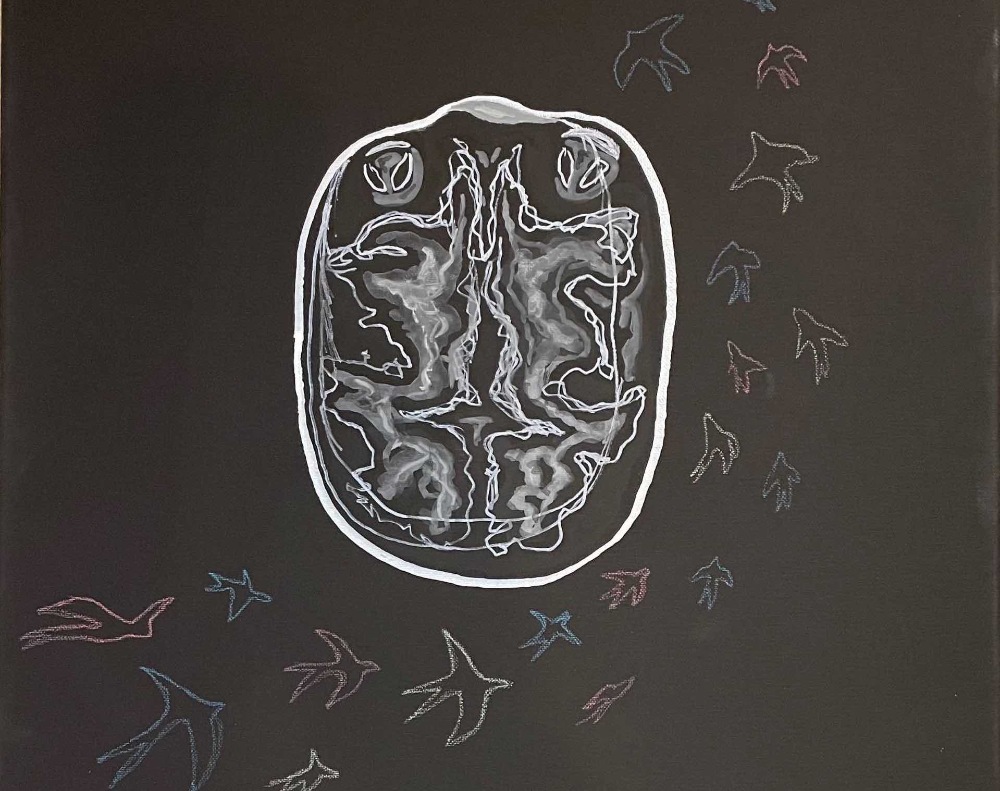
Painting by Katelynn Bennet, final project from Craig Jude's Often Awesome: The Biology and Humanity of ALS class.
When biology students learn about diseases, there is often an important element missing – the stories of the people whose lives have been affected by the condition. This is not the case, however, for one unique course about ALS taught at Bard College in New York. Students taking Craig Jude’s class “Often Awesome: The Science and Humanity of ALS” learn about the disease’s biology, its symptoms, how it affects motor neurons, and what we know and don’t know about its causes. They also gain important context about what ALS does to the lives of real people.
Throughout the class, as students learn about how the disease affects the body, they simultaneously watch episodes of the web series “Often Awesome.” Across the 36 episodes, the series follows the journey of Tim LaFollette and his wife Kaylan, beginning after Tim was diagnosed with ALS at the age of 29, and continuing through his passing in 2011 from the disease. Craig says he was introduced to the series through his wife’s college roommate, Rachel Jones – Tim’s sister.
“When I first saw it, it gave me the idea that this would be a good way to bridge the science and the humanity of a disease like ALS,” he says. “But also, in a way, to help the message of the web series continue. To bring it to a new group of people who might have never seen it.”
Craig knew that grounding science in a human story was important to reach the students he was hoping to attract to the course. Bard, a liberal arts college has a lab science for all students, even those not majoring in STEM fields. That meant he would be teaching the biology of an incredibly complex disease to students with majors like English, fine arts, history, or philosophy. But he believed Tim’s story would help ground the science of what ALS does to the body in the reality of what it does to a person’s life – and help emphasize the importance of learning more about the disease.
“The group of people that Tim had around him, his group of friends that helped support his ALS journey, are a group of people that would have fit in really easily as students at Bard,” says Craig. “It was a very artistic, very outgoing group of people. I could see the story translating well to the Bard students – the messages, the ideas, and the way that people were acting in the series. This class is geared toward people who might have been trying to avoid taking their lab science requirement the entire time they’ve been at college – I thought this would make things less scary.”
Craig designed the course so that students would see the concepts they learn each week in their labs and classes reflected in Tim’s real-life experiences. One week, a lab assignment might involve using an EMG to measure grip strength – that same week, students would watch an episode about how the test played a part in Tim’s diagnosis process. Another class, they learn about opportunistic infections that can co-occur with ALS – and watch an episode in which Tim struggles with pneumonia. Each year, Tim’s sister Rachel will also join the class to give the students a first-person perspective on what it’s like to see a loved one go through ALS.
“Because the students are seeing Tim as the face of ALS through this web series,” says Craig, “it makes them look beyond just the facts and figures and numbers and actually see how all these things we talk about in class are affecting a person. The series shows a lot of what an ALS patient goes through. So, they see all of the stages of losing abilities, losing speech, losing the ability to breathe. They not only hear me talk about it and see things in class, but then they see someone physically going through it on the screen.”
Over the six years he’s now been teaching the course, Craig says he has heard from many students who were dreading fulfilling their science requirement, but found this unique format made it relatable. Perhaps even more importantly, it’s also introduced a number of students who may have never heard of ALS to the disease – and the desperate need for more research and treatments.
“I’ve heard from students, after they’ve taken the course, that it’s given them a bridge to discussing ALS with other people,” he says. “They take the information they get about ALS and share it with their families, with their friends outside of class. So, in a way, it actually furthers the end goal that, according to Rachel, Tim had for the web series. It’s continuing to spread awareness and get the word out about ALS.”
For most people with ALS, there are no treatments to stop or significantly slow progression. The ALS Therapy Development Institute (ALS TDI) is the largest drug discovery lab in the world that is solely dedicated to doing research to end ALS. You can learn more at https://www.als.net/als-research/.
What to do next: